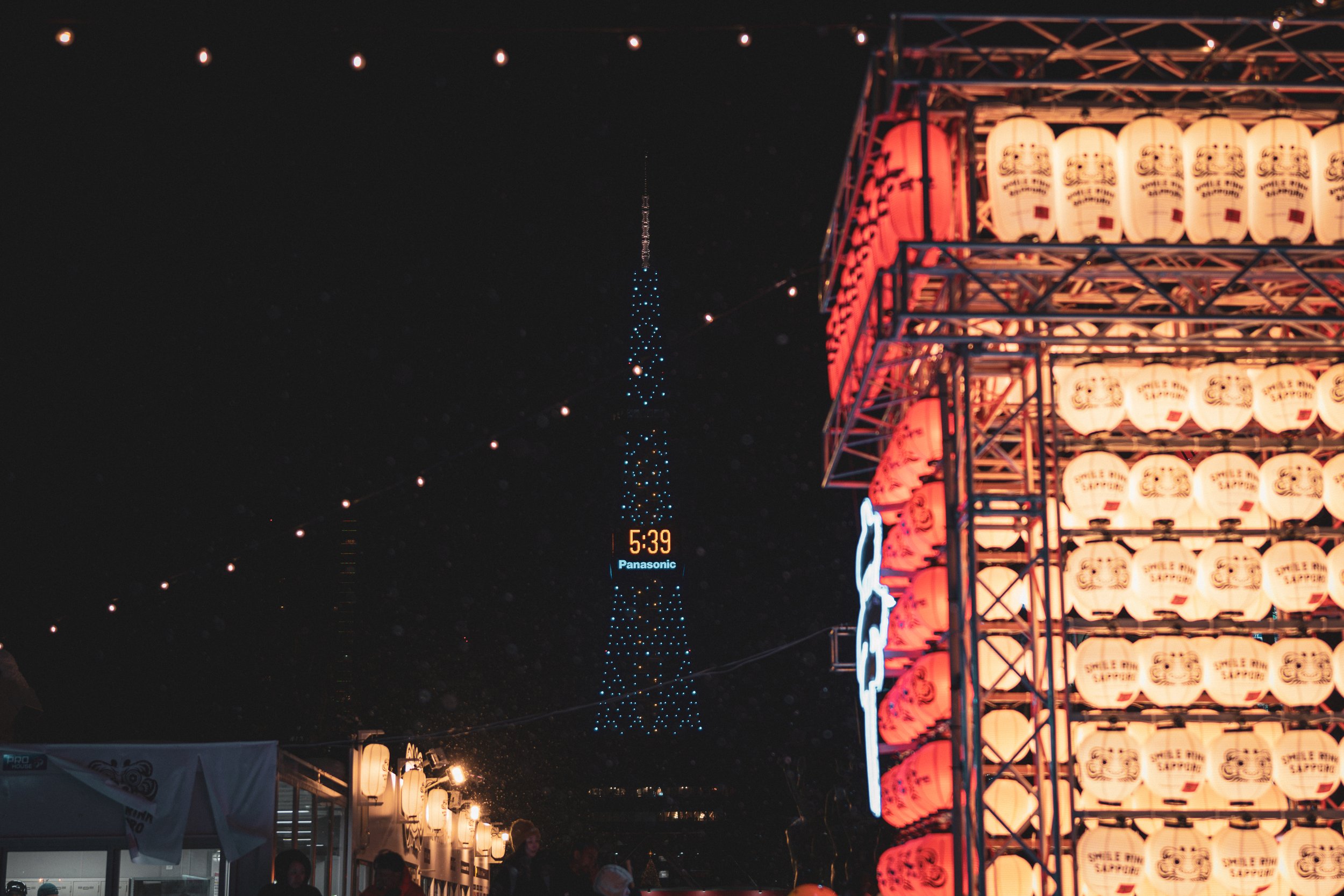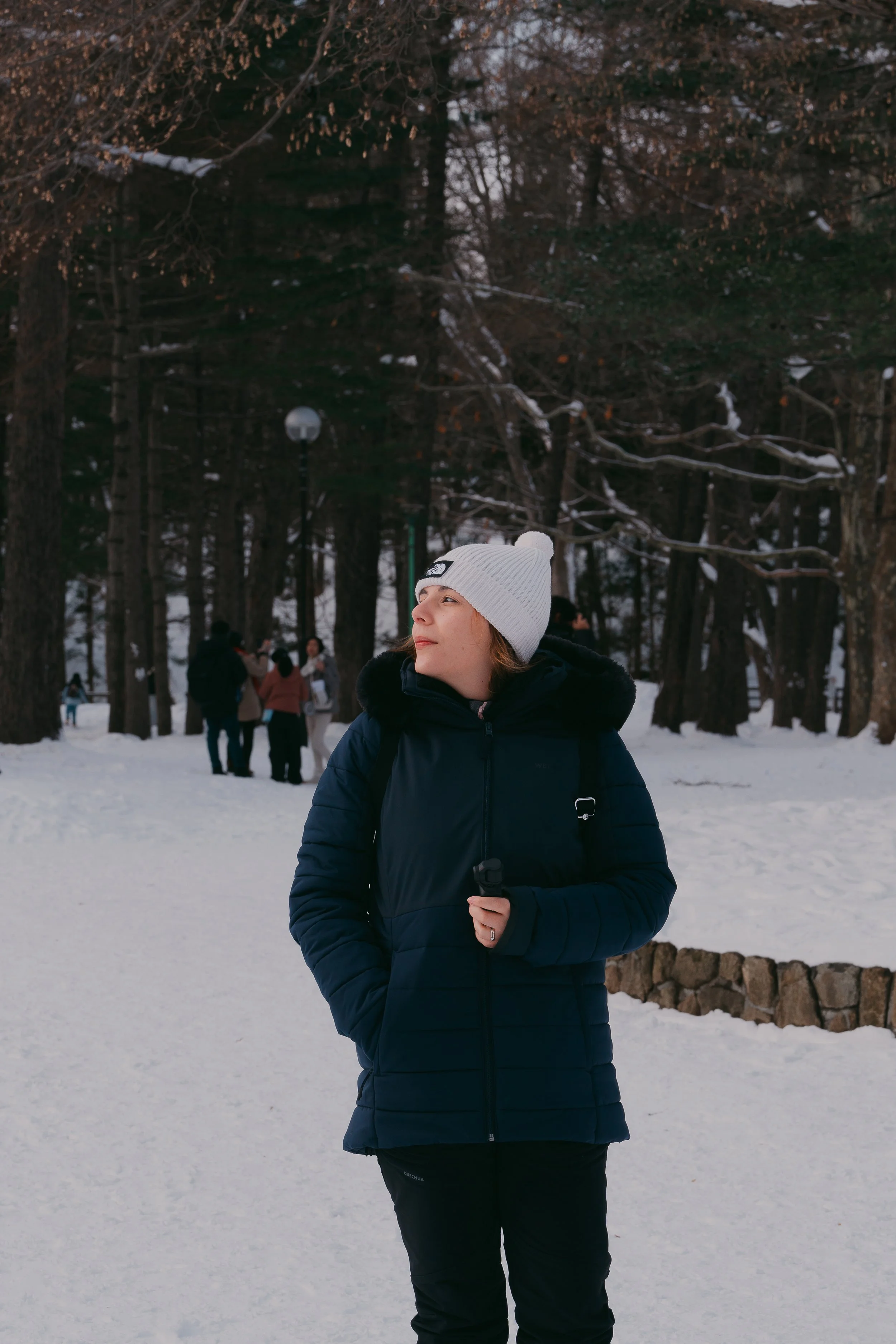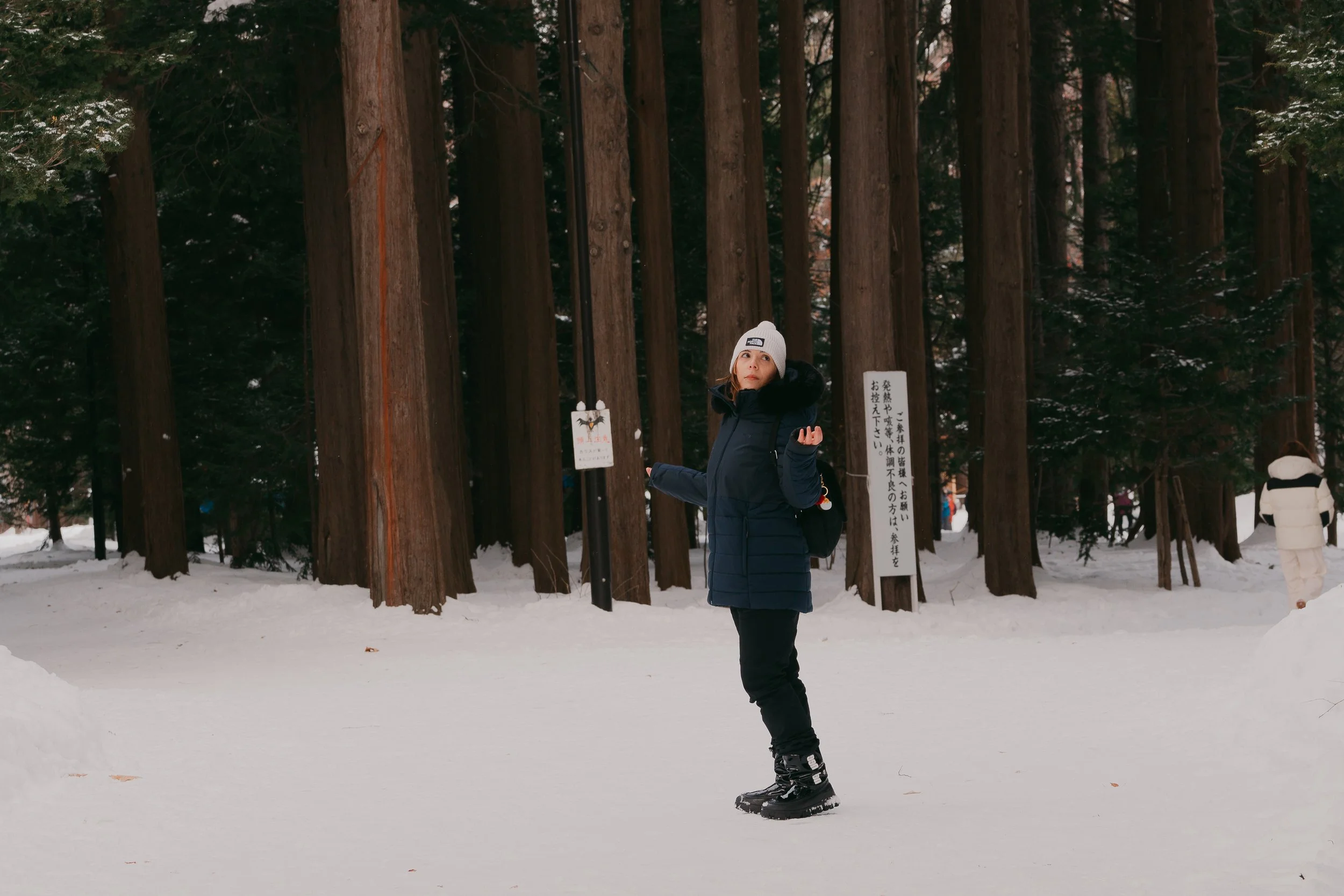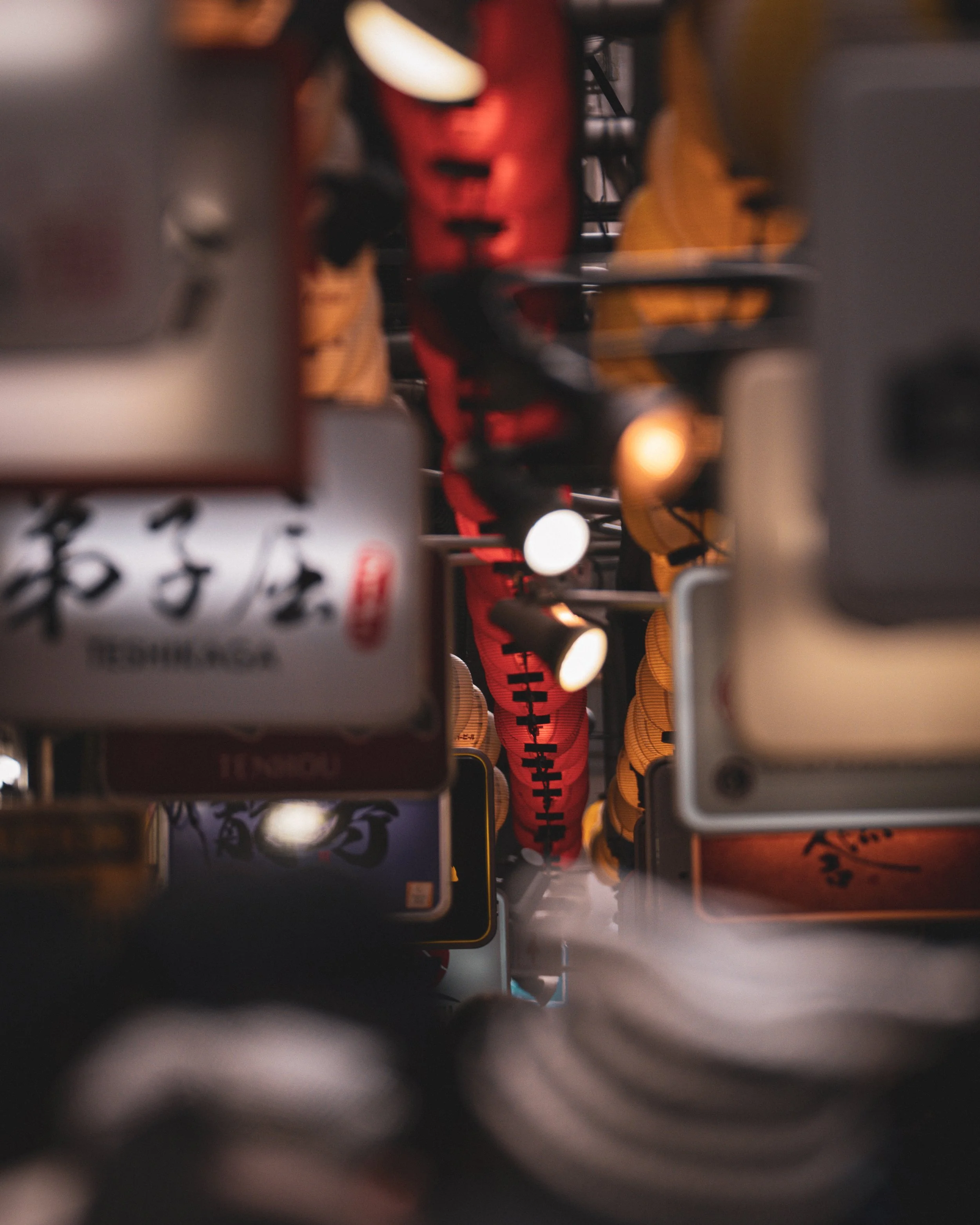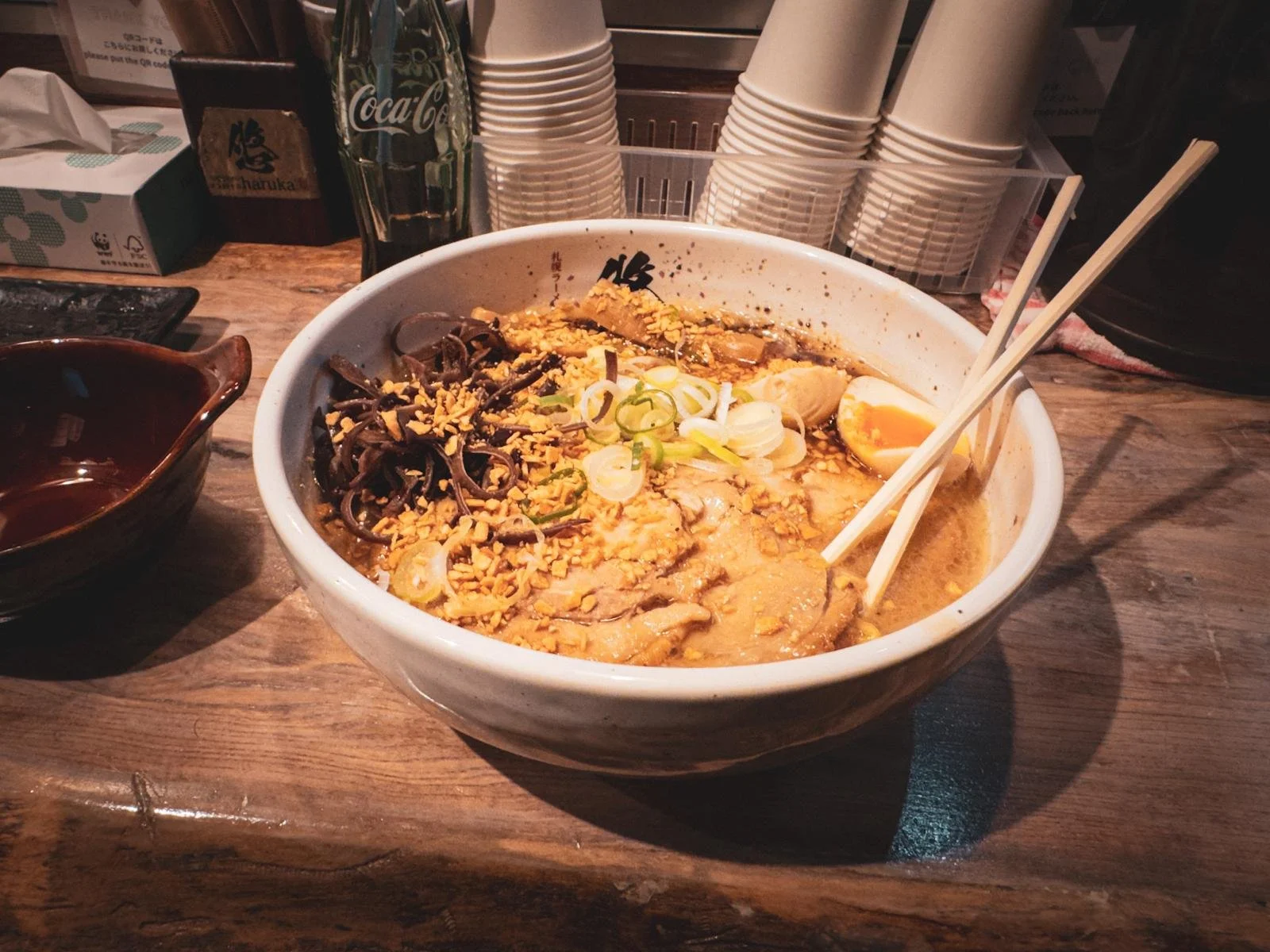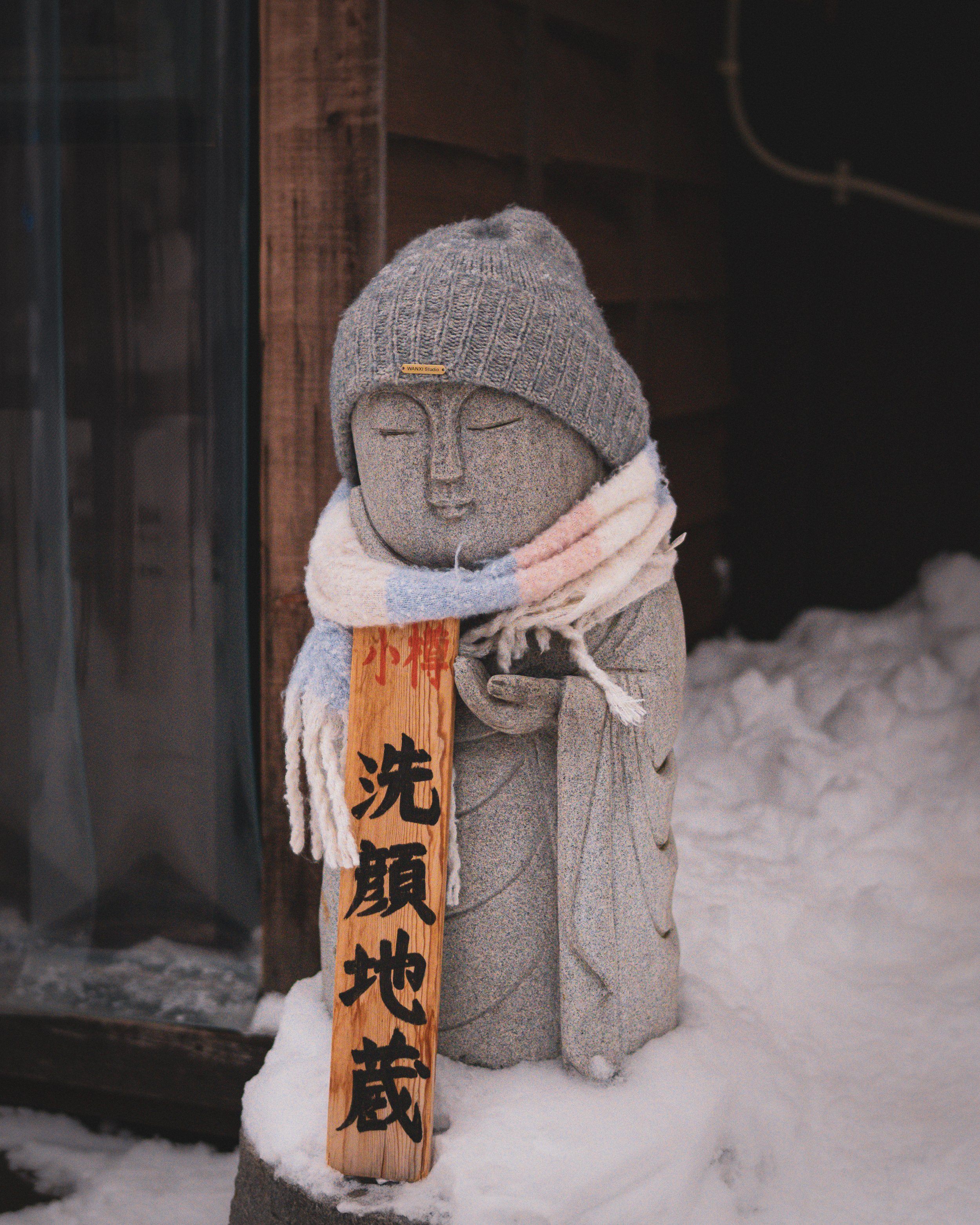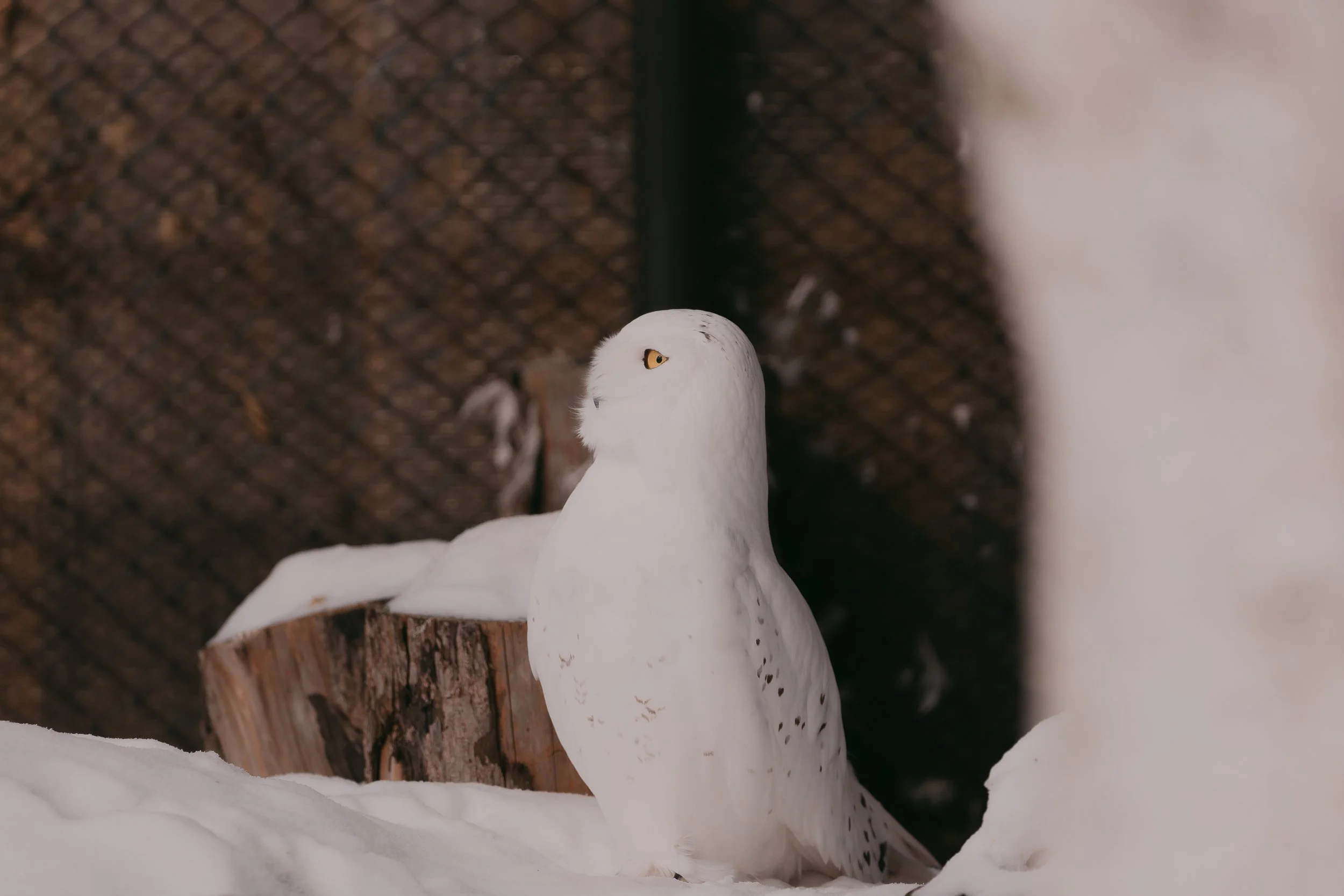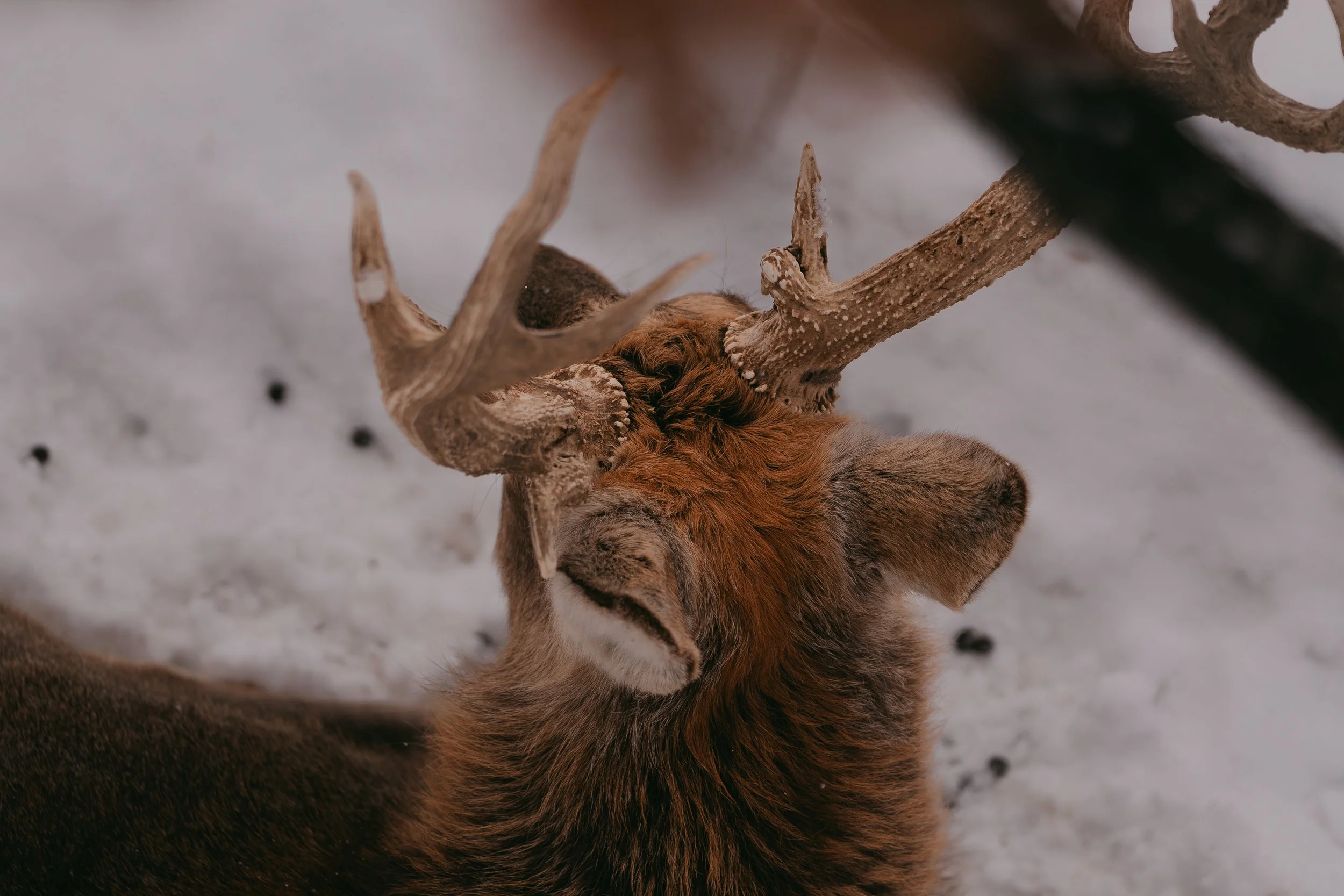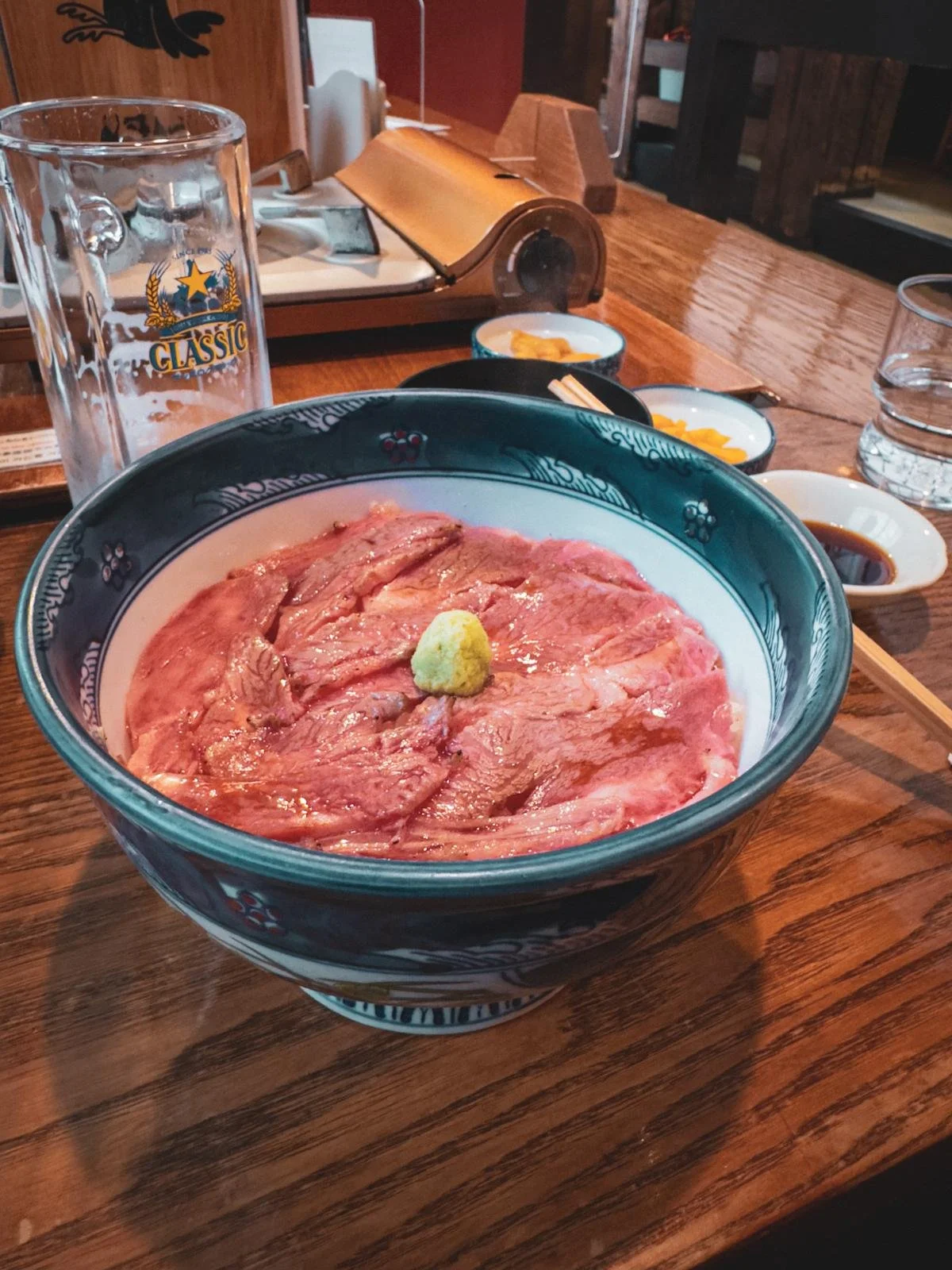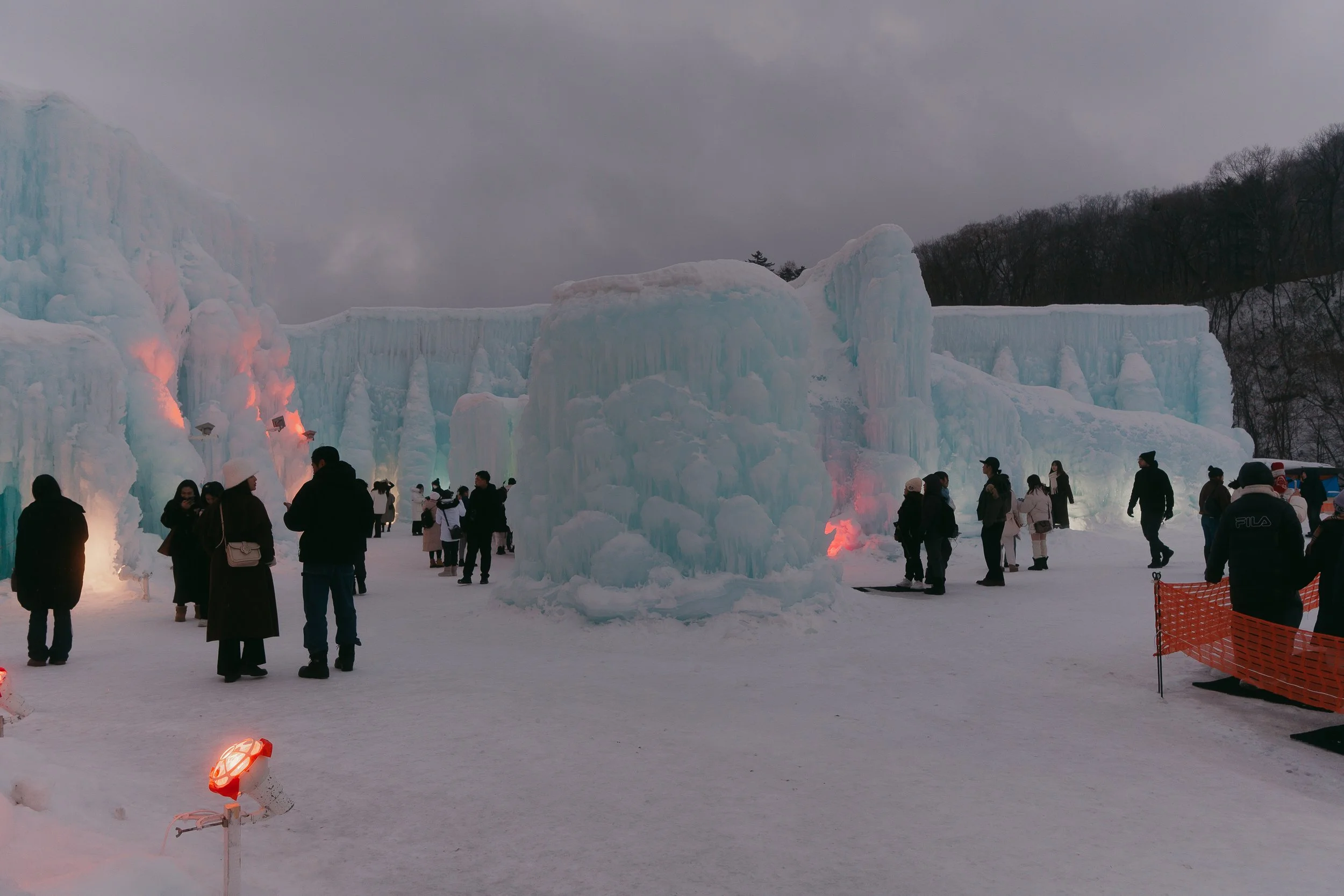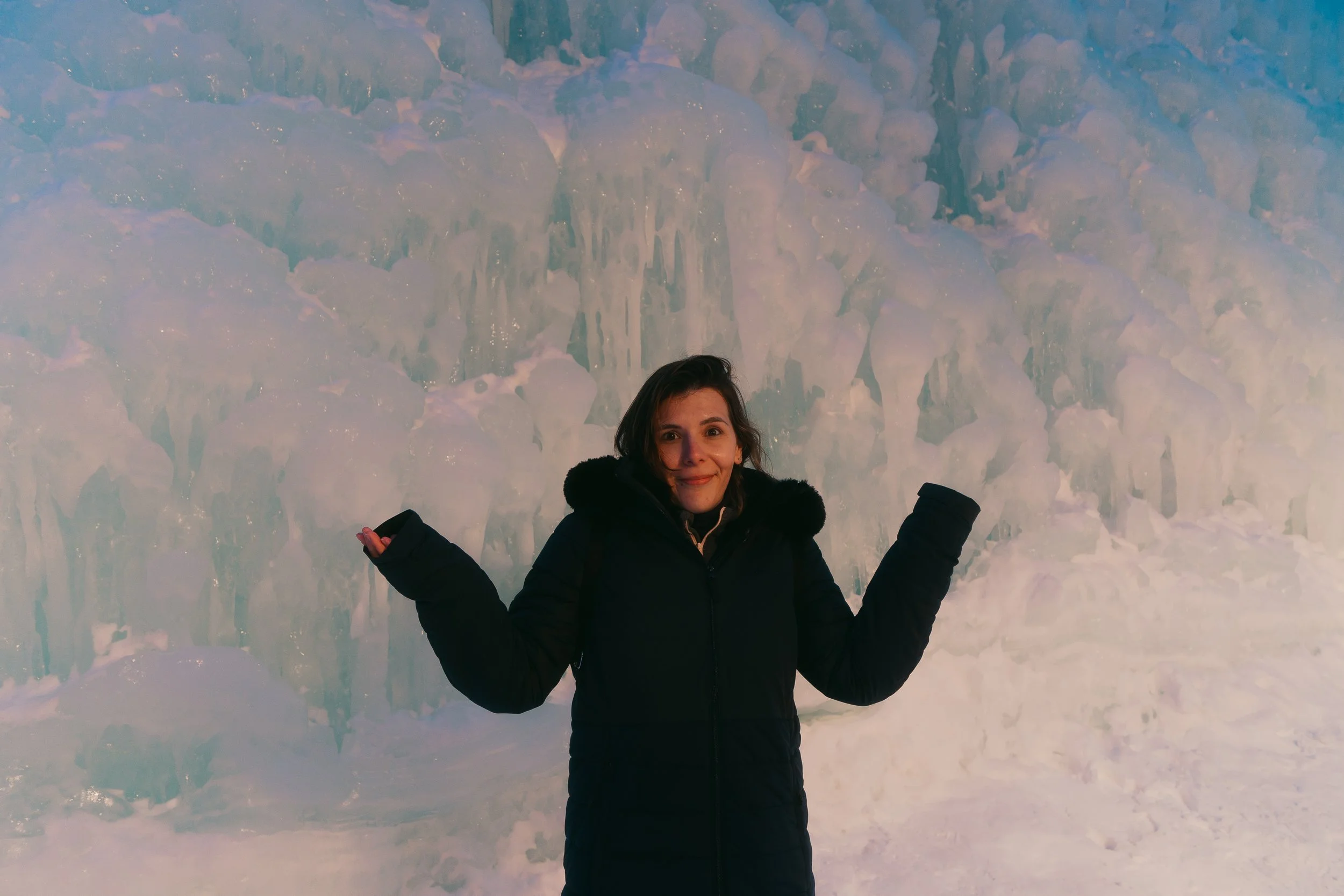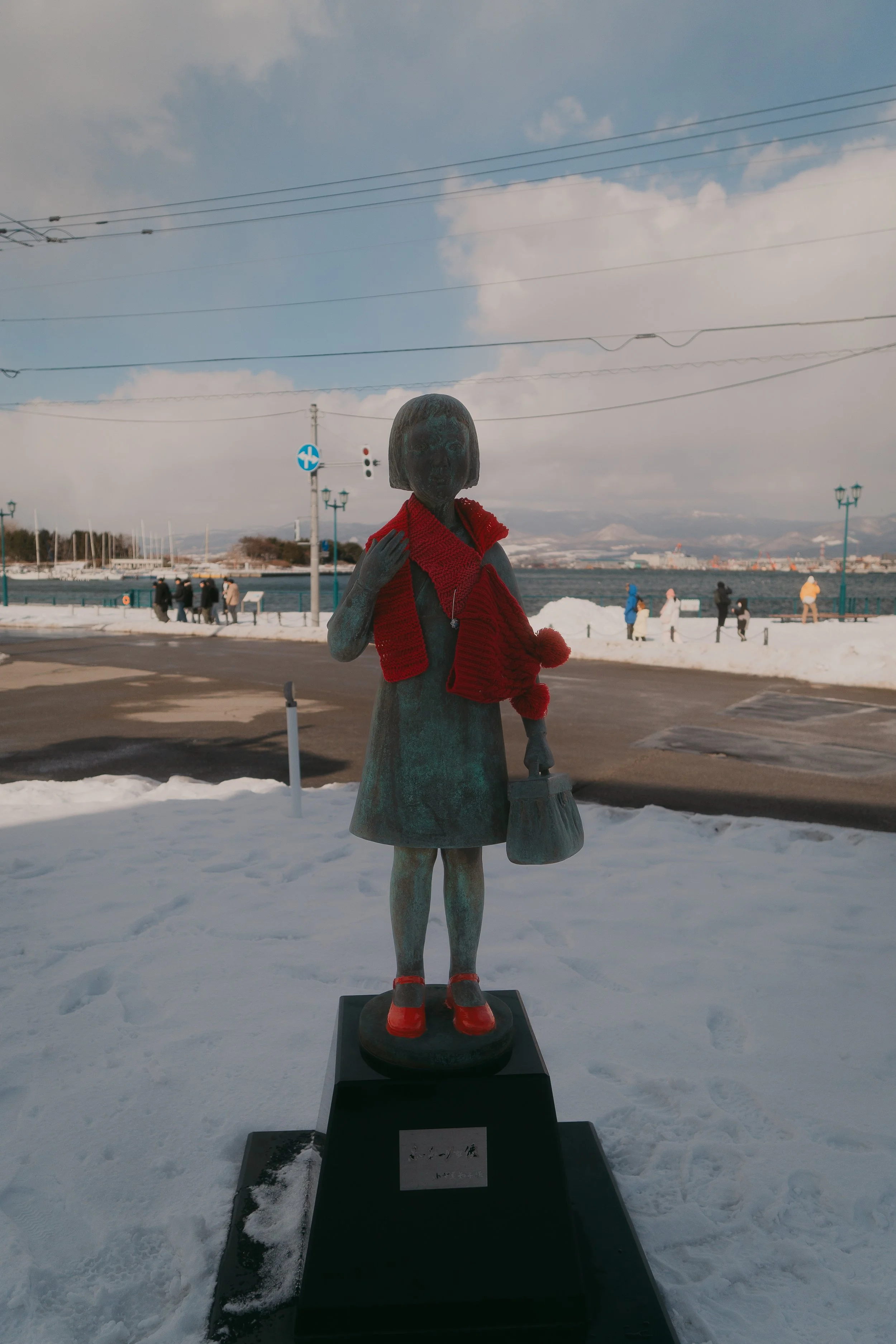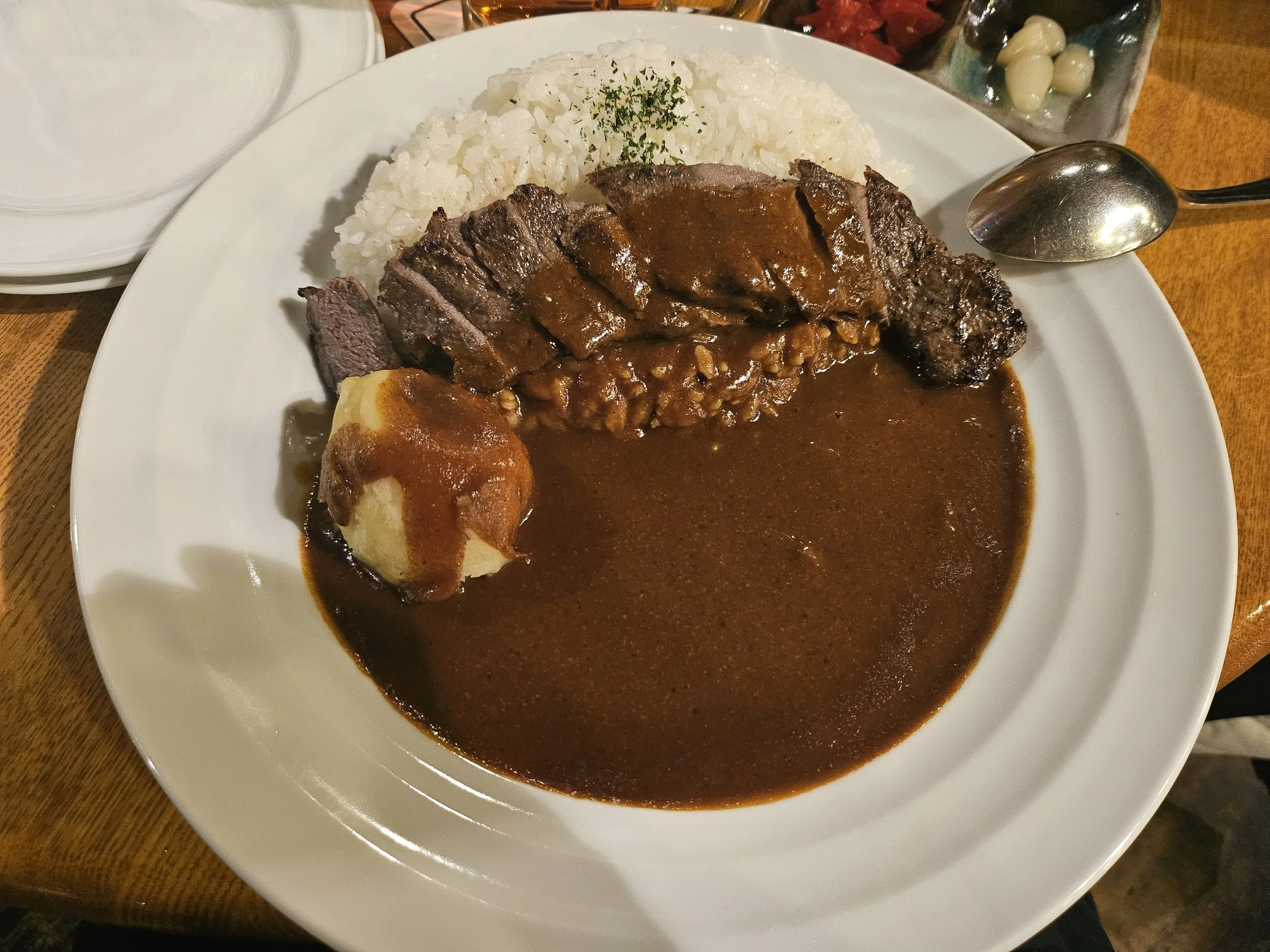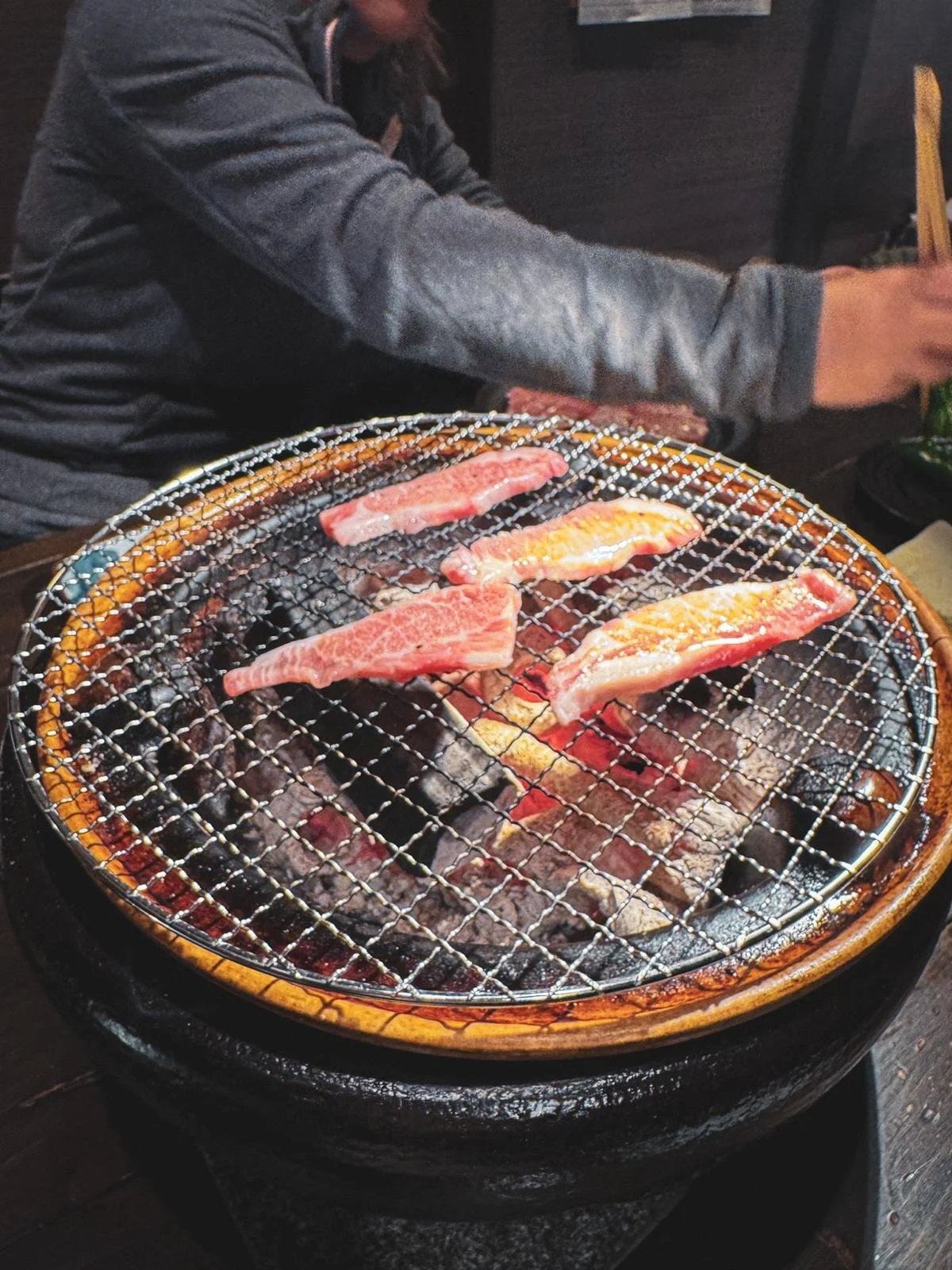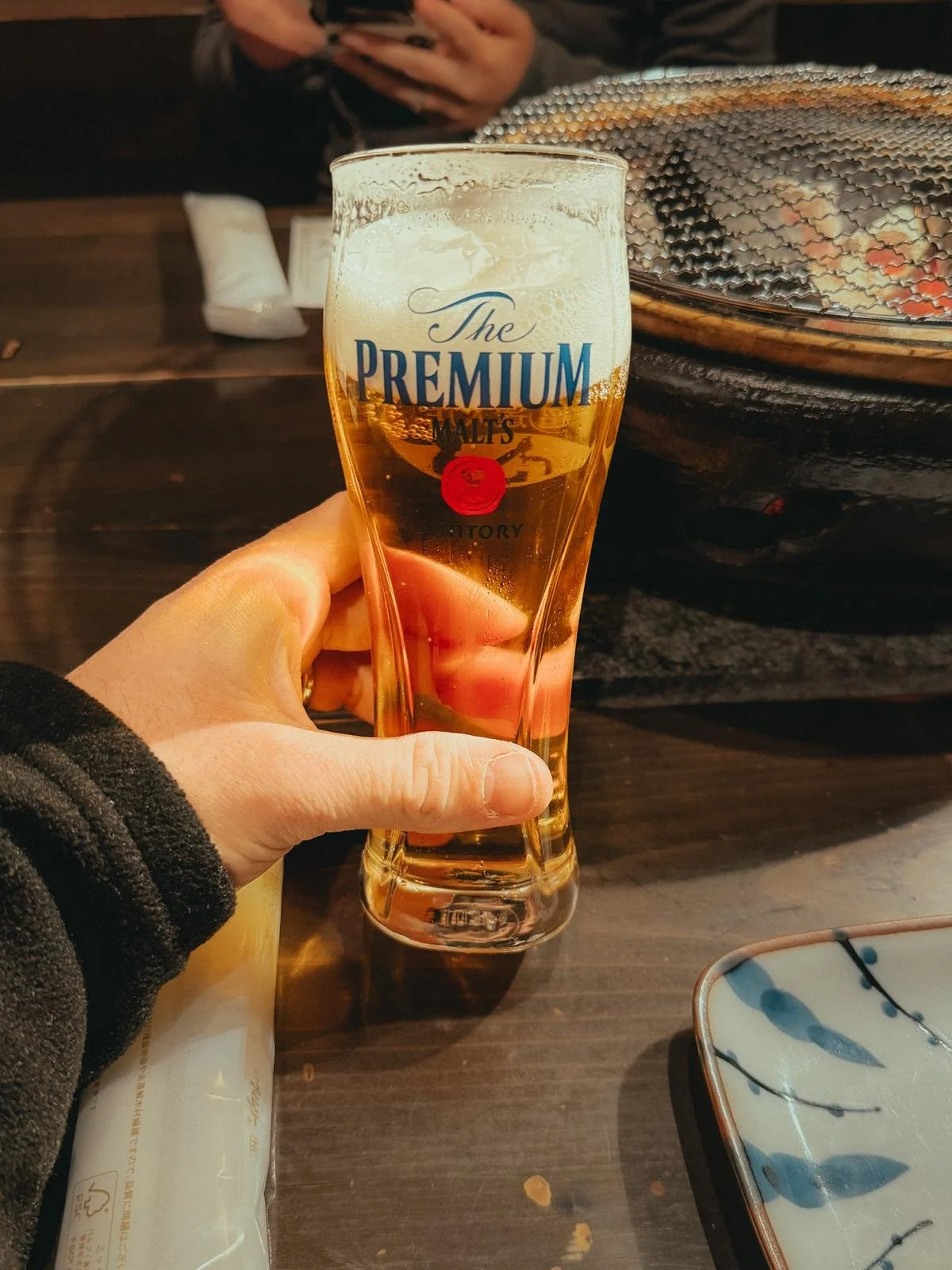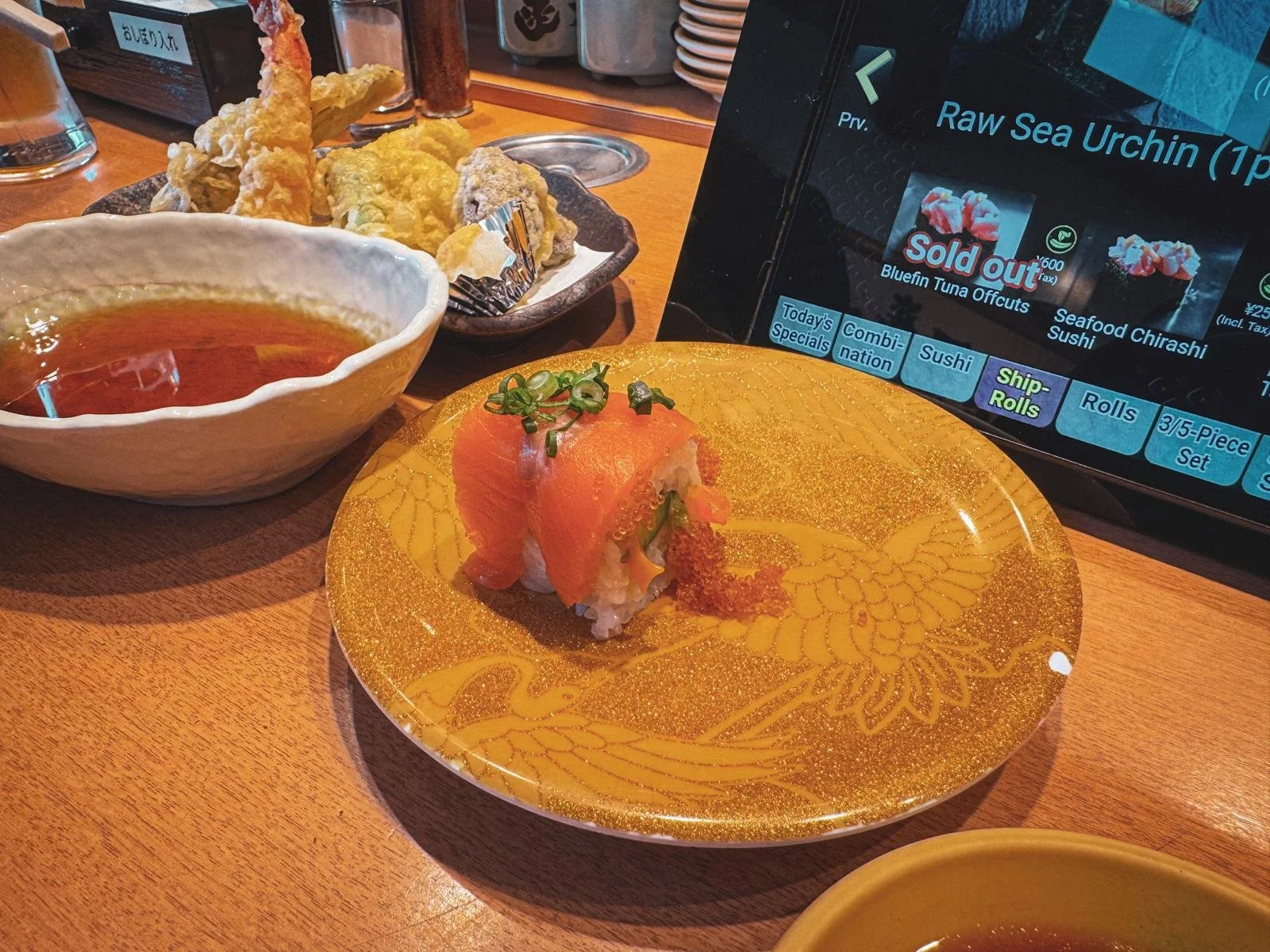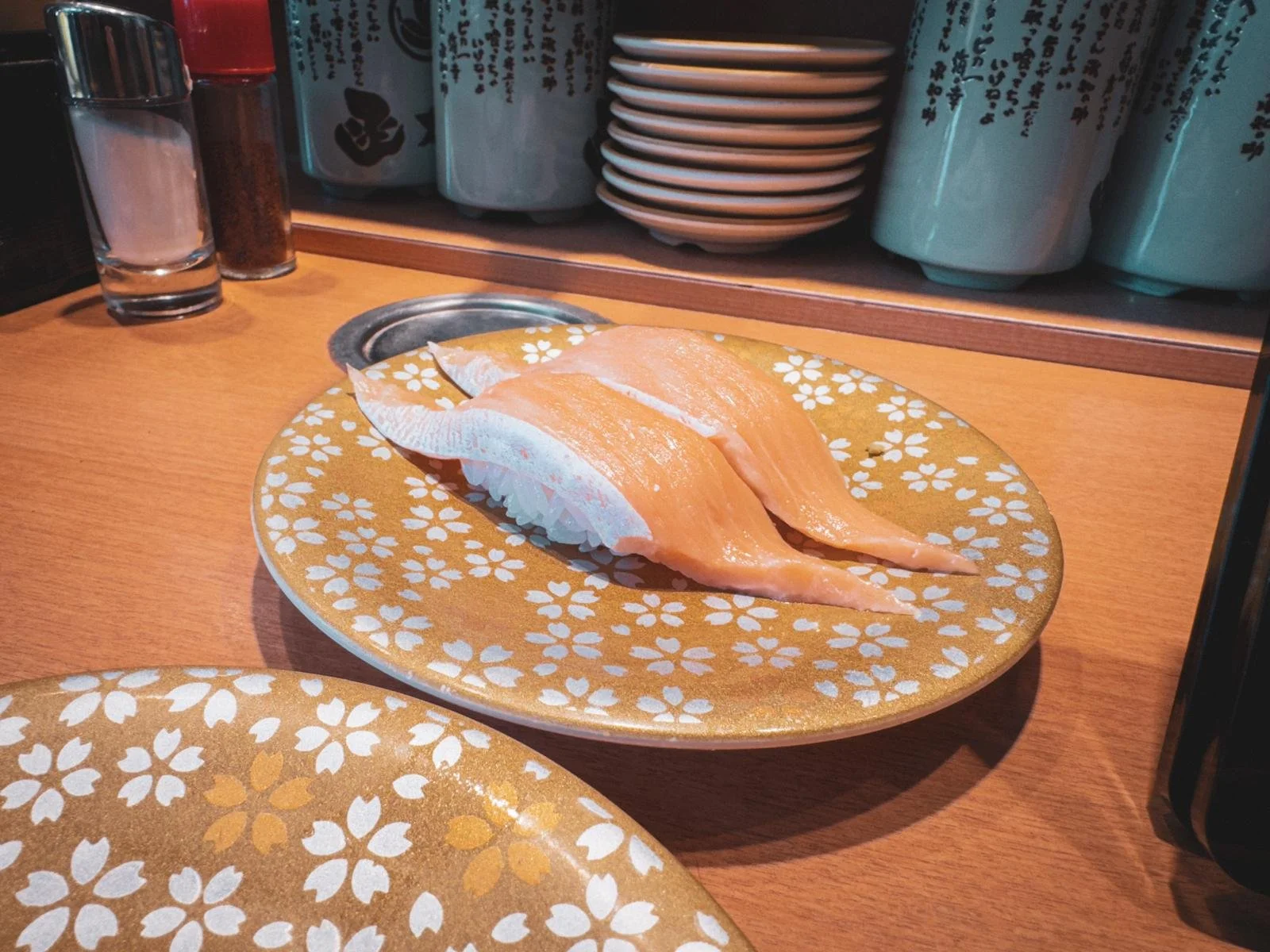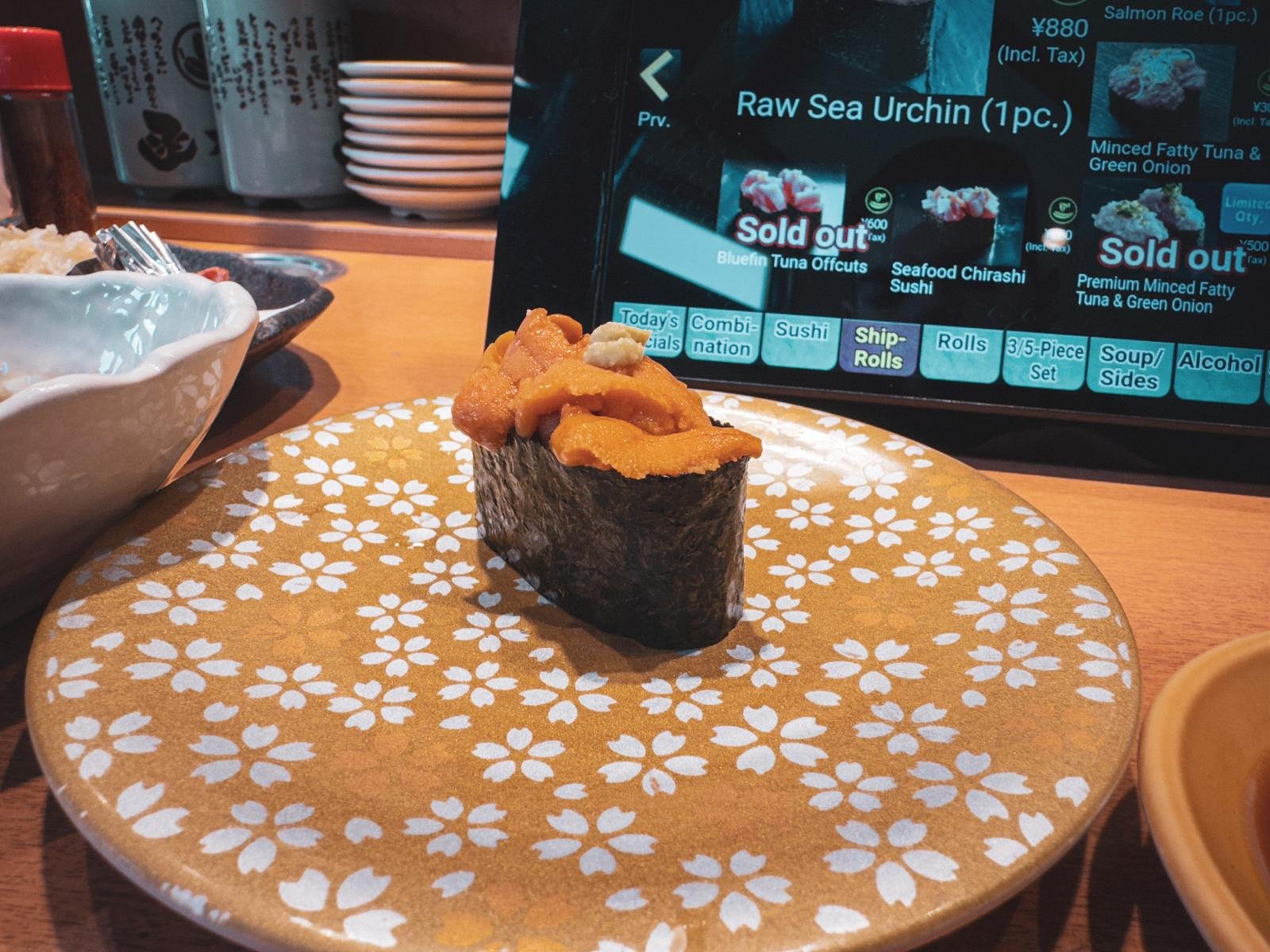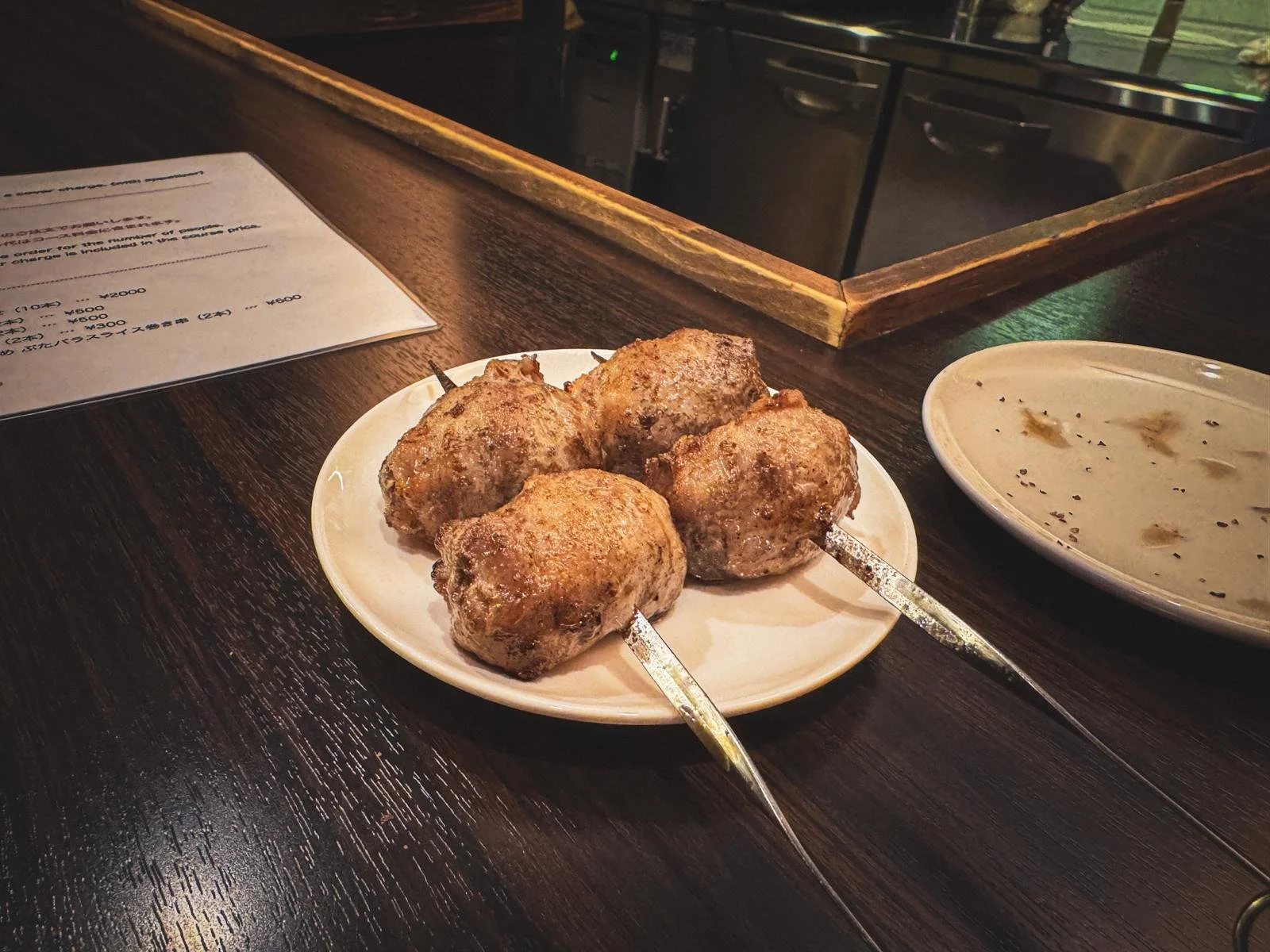Hokkaido: Two-Week Winter Wonderland
Part of our epic Japan adventure, after a sunny escape to Okinawa (check our detailed guide here—shameless plug), we ventured to the northern gem, Hokkaido. This amazing island is filled with snowy landscapes, piping hot bowls of ramen, and enough Instagrammable moments to fill up Vasco’s and anyone’s memory cards.
We timed our visit for early February to fulfill a bucket list dream: seeing the Sapporo Snow Festival in all its frosty glory. We are here to share all the details about it and our itinerary for 14 unforgettable days in Hokkaido!
JUMP TO A CATEGORY
Flights: How We Got There
Coming from Okinawa, we booked our flights with Peach Airlines, one of Japan’s budget airline. Whether you're coming from Okinawa like us or heading directly to Hokkaido, expect a layover in Tokyo or Osaka. Sometimes booking domestic flights separately can snag you better schedules or prices, so keep that in mind!
For our flight from Naha to Sapporo, we paid around €200/$210 per person, including baggage. Not bad for a cross-country hop that ended with us stepping into a winter wonderland.
Getting Around Hokkaido: Transportation Tips
Deciding how to explore this snowy island was a challenge that even Sara’s spreadsheets struggled with. After much deliberation, here’s what we settled on:
JR Pass or Not?
We skipped the JR Pass this time (not just because of the big price increase). While a 14-day pass costs about €517/$545 per person, we realized it wasn’t worth it for our itinerary.
Instead, we opted for the Kitaca and Sapica IC cards for local transport and bought individual Shinkansen and limited express train tickets as needed. You can use a JR Pass calculator online to see what works best for your travel plans.For a 2-week stay, we would recommend nevertheless considering the JR Hokkaido regional pass if it aligns with your itinerary. Keep in mind they offer only 7-day options, so you’d need two passes, unless you time your stay masterfully, costing about €330/$347 per person.
Car Rental?
No thanks! Driving in snowy conditions wasn’t on our to-do list. Plus, public transport and tours in Hokkaido are excellent. But if you are planning to come to Hokkaido during a different season it is definitely worth it!Tours for the Win
To reach places like Asahikawa and Noboribetsu, we booked tours that included transportation. Not only was it convenient, but it made sure we hit all the main points of interest without as much hassle.
Stay Connected: Pocket Wi-Fi
As we mentioned in our Okinawa guide, since we were spending six months in Japan, reliable internet was non-negotiable. We rented our Pocket Wi-Fi from Japan Wireless, which offers flexible plans for short and long stays. They even deliver it to your hotel or the airport.
Returning it is as simple as dropping the prepaid envelope into a mailbox at the airport (before security!) on your last day.
Photography Gear Suggestions
These recommendations are based on the gear we used to capture Hokkaido’s breathtaking landscapes, vibrant cityscapes, and unique winter festivals. Our Sony A6700 (cropped sensor) paired with the Sigma 10-18mm f2.8 for wide shots and vlogs, the 35mm f1.4 for portraits and street photography, the 70-200mm f2.8 for wildlife and zoom shots, and the 16mm f1.4 for night and astro photography. We used a Marumi Black Mist 1/4 filter ( this is an equivalent) for a cinematic look and the Freewell M2 kit for ND and UV filtering. Our DJI 4K Pro Mini is also a great way to get aerial shots where you have permission to fly (check our Drone flying in Japan blog post here).
Sapporo Snow Festival— Best Lens: Sigma 10-18mm f2.8 (wide festival shots), Sigma 35mm f1.4 (details & portraits). Use the 10-18mm for wide shots of massive snow sculptures and bustling festival crowds. Switch to the 35mm f1.4 to capture details in ice carvings and candid street portraits.
Drone Note: Flying drones here is prohibited due to crowds.
Susukino Street— Best Lens: Sigma 35mm f1.4 + Marumi Black Mist 1/4. The 35mm f1.4 is perfect for moody street photography, while the Marumi Black Mist filter adds a cinematic glow.
Otaru— Best Lens: Sigma 35mm f1.4 (canal & streets), Sigma 10-18mm f2.8 (architecture). Walk Sakaimachi Hondori Street for vintage architecture, where the 35mm f1.4 excels.
Drone Note: Some areas around the canal have flight restrictions—check local rules.
Hill of the Buddha— Best Lens: Sigma 10-18mm f2.8 (landscape), Sigma 35mm f1.4 (Buddha details). Use the 10-18mm to capture the grandeur of the surrounding lavender field in summer or snow-covered stillness in winter.
Blue Pond & Biei Falls Illumination— Best Lens: Sigma 16mm f1.4 (night photography), Sigma 10-18mm f2.8 (daytime shots). The Blue Pond is famous for its ethereal, almost surreal blue hue. Use the 10-18mm to capture reflections on still water during the day. At night, the Biei Falls Illumination transforms into a magical light display—perfect for the 16mm f1.4 in low light.
Drone Tip: Allowed in certain areas, but avoid flying over the pond itself.
Ningle Terrace— Best Lens: Sigma 35mm f1.4 (charming cabins), Sigma 16mm f1.4 (night & snow scenes). The 35mm f1.4 is great for capturing cozy details, while the 16mm f1.4 works wonders for nighttime snow-covered shots.
Mount Hakodate Ropeway— Best Lens: Sigma 16mm f1.4 (cityscape at night), Sigma 70-200mm f2.8 (distant details). The 16mm f1.4 is ideal for capturing the full cityscape below. If you want close-up details of the coastline or the iconic curving lights of Hakodate, switch to the 70-200mm.
Drone Note: Drones are not allowed near the ropeway or observatory.
Hell Valley (Jigokudani)— Best Lens: Sigma 10-18mm f2.8 (landscape), Sigma 70-200mm f2.8 (geothermal vents). Use the 10-18mm for epic wide shots of sulfuric vents, while the 70-200mm lets you zoom in on bubbling hot springs.
Drone Tip: Drones are not permitted due to safety concerns.
Goryokaku Park & Tower — Best Lens: Sigma 10-18mm f2.8 (wide shots), Sigma 70-200mm f2.8 (aerial perspectives). From the ground, use the 10-18mm to capture its full expanse. If you’re viewing from the Goryokaku Tower, the 70-200mm helps zoom in on intricate fort details.
Drone Tip: Some flight restrictions apply—check before flying.
Itinerary
Day 1: Welcome to Winter Wonderland
We arrived at Sapporo’s Chitose Airport in the afternoon after a 3.5-hour flight from Naha—talk about a weather shock! From tropical breezes to freezing temperatures in the blink of an eye.
For our stay, we booked Hotel Emisia Sapporo, slightly outside the city center but conveniently located right next to Shin-Sapporo Station. It made getting around a breeze, and the extra comfort was worth it.
Even after a travel day, we couldn’t resist heading out to make the most of our first evening:
Our first stop was, of course, the famous Odori Park, a hub for the Sapporo Snow Festival. Wandering among the massive, glowing snow sculptures was mesmerizing—like stepping into a frosty art gallery. Even Vasco’s hands nearly freezing to the camera was worth every shot. (Pro tip: bring hand warmers. Lots of them.)
We ended the day exploring Susukino Street, soaking up the neon-lit atmosphere. Neon lights glowed in every direction, and the smell of ramen was impossible to ignore. Naturally, we gave in and grabbed dinner at Isono Kazuo, where we tried their famous “Sapporo Black” Ramen. Rich, bold, and deeply satisfying—it was the perfect way to end a cold day.
Day 2: Exploring time
No time for a slow start—Day 2 in Sapporo was all about exploring the city’s highlights!
Morning:
You can start your day at the bustling Sapporo Crab Market. The fresh seafood displays are an experience in themselves, and if you’re a fan of crab (or just want to marvel at the sheer size of them), this is the place to be. It’s a great spot for photos, a snack, or even just soaking in the atmosphere.
After that, you can take stroll along Tanukikoji Shopping Street, one of Sapporo’s iconic shopping areas. This covered arcade is perfect for window shopping or picking up souvenirs. From quirky snow-themed trinkets to local treats, there’s something for everyone—and you might just leave with more bags than you planned like we did!
Lunch:
Warm up with a hearty bowl of ramen at Teshikaga Ramen (because if not in Sapporo during the winter, when?). This spot serves up rich, flavorful broth and perfectly cooked noodles that will have you feeling ready to tackle the rest of the day.
Afternoon:
After lunch, you can head to the Sapporo Clock Tower, one of the city’s most historic landmarks. It’s a quick visit, but it’s a worthwhile stop.
Late Afternoon and Dinner:
Time your visit like we did to the Sapporo TV Tower for golden hour. The city views from the observation deck are stunning, especially as the warm sunset light bathes the snowy rooftops. Pre-book your tickets to save time and ensure you get there at the perfect moment.
If you are visiting during the Sapporo Snow Festival you can have dinner below the TV Tower, where they have tons of little food stalls with all kinds of delicious treats for you to try!
Day 3: Can’t get enough of Sapporo
Fill your day with full of culture, food, and, of course, more ramen.
Morning: Maruyama Park and Hokkaido Jingu
We started our day at Maruyama Park, a large and beautiful green space in Sapporo that’s perfect for escaping the city hustle. In the heart of the park is Hokkaido Jingu, a Shinto shrine surrounded by tall trees and a calming atmosphere. We took our time here, wandering around the grounds and appreciating the quiet beauty of the place. It’s the kind of spot that makes you feel at peace with the world—especially when the snow gently falls around you. Just make sure you are well dressed for the cold!
Lunch: Kitamaruyamakyoju (Japanese Curry)
By this point, if you are getting pretty hungry, head to Kitamaruyamakyoju, a Japanese curry restaurant, which is Sara’s absolute favorite. If you love Japanese curry, this place is a must-try.
Afternoon: Park Nakajima and Hohei Kan
After lunch, you can wander to Park Nakajima, another peaceful green space that’s perfect for a little downtime. From there, check out the Hohei Kan, an old western-style building near the park that offers a nice contrast to the more traditional Japanese architecture around town. It’s a quirky spot that stands out!
Late Afternoon: Susukino Street
Our next stop was Susukino Street, where we were determined to do a little more exploring.
Dinner: Sapporo Ramen Hakura
We wrapped up the day with a hearty bowl of ramen, again, at Sapporo Ramen Hakura. We know it’s getting repetitive, but after days of exploring, nothing beats the warm, savory comfort of Sapporo-style ramen, trust us. We 100% recommend the very typical butter corn Ramen. Trust us.
Day 4: Otaru Adventure
After some Sapporo exploration, we recommend you head out and discover another gem of Hokkaido: Otaru! Located about 1.5 hours from Sapporo, Otaru is a charming port city known for its canals, historic warehouses, and—of course—amazing food and drinks. Here’s how you can make the best out of our day there:
Morning: Nikka Whisky Yoichi Distillery
Kick off your Otaru day with a visit to the Nikka Whisky Yoichi Distillery. If you’re a fan of whisky (or even if you’re just a casual drinker like us), this place is a place to consider. Here you can learn all about the distillation process and the history of Nikka Whisky, founded by a Japanese whisky legend.
Late Morning: Otaru Music Box Museum
After the whisky tasting, head to the Otaru Music Box Museum, a spot filled with delicate, antique music boxes. Sara was ready to take home every music box she could find. It’s the kind of place where you can easily lose track of time. You can stroll through the Sakamachi Hondori street to get there by foot and stop by the Snoopy Café and Store in the area!
Lunch: Beef Cutlet Otaru Kurosawa
By this point, if you are anything like us, you will be seriously hungry and in the mood for something hearty. We went to Beef Cutlet Otaru Kurosawa—a hidden gem serving up incredible katsu (breaded and deep-fried cutlet) dishes. The katsu was perfectly crispy, and the beef was tender and flavorful. We devoured it quickly, and it became one of our favorite meals in Otaru. If you’re a katsu lover, don’t miss this spot!
Afternoon: Otaru Beer Warehouse No. 1
As we wandered around the Warehouse District, we stumbled upon Otaru Beer Warehouse No. 1, where we stopped for a refreshing drink (because when in Otaru…). The warehouse, with its brick walls and cozy, rustic vibe, is a great place to sample some local brews.
After our drink, we took a walk around the Warehouse District and the Canal, which is one of the most picturesque spots in Otaru. The warehouses, many of which have been converted into shops and cafes, line the canal, creating a perfect blend of history and modern life. It’s an ideal spot for taking photos. If you are here during the Sapporo Snow Festival, you can also check out the Otaru Snow Light Path Festival.
Evening: Otaru Tenguyama Ropeway
To cap off the day, we rushed to the Otaru Tenguyama Ropeway, which takes you up to a viewpoint offering stunning views of the city and the sea. We had pre-booked our tickets a few days earlier, and it was totally worth it. The golden hour light over Otaru was absolutely magical, making the city’s canals and rooftops glow in warm hues.
Day 5: Relaxed Sapporo Day
After all the action-packed days, we suggest you take it easy and enjoy some of the more leisurely attractions that Sapporo has to offer.
Late Morning: Soseigawa Park
You can start the day a little later, catching up on much-needed rest after the last few busy days. You can stop at Soseigawa Park, a peaceful spot that’s perfect for unwinding. You can easily spend here an eternity, if it weren’t for the cold, strolling along the river and enjoying the serene surroundings.
Lunch: Wagyu ShabuShabu Sukiyaki Fujiyama
We suggest you head out to Wagyu ShabuShabu Sukiyaki Fujiyama, where you can enjoy premium wagyu beef in the form of a hot and satisfying shabu-shabu and sukiyaki meal.
Afternoon: Sapporo Beer Museum & Shiroi Koibito Park
After lunch, dive into some local culture, starting with a visit to the Sapporo Beer Museum. If you’re a beer fan, this place is a must-see. You can learn all about the history of Sapporo’s beer, and naturally, have a beer tasting session (because...research, right?).
From there, make your way to Shiroi Koibito Park, an adorable chocolate-themed park. The park is home to the famous Shiroi Koibito cookies, and you can even watch them being made as you stroll through the park.
Evening: Relax and Explore Sapporo at Night
After all the sightseeing and indulging, we suggest you keep it low-key in the evening. Sapporo is beautiful at night, especially when the city lights shimmer on the snow.
Day 6- Heading to Asahikawa
This was our day to venture into the wilderness—time to trade neon lights for penguins and sake! We woke up extra early (reluctantly, let’s be honest) because Asahikawa is about 2.5 hours away from Sapporo (by limited express, so brace yourself for the price), and we wanted to make the most of it.
Morning:
Our first stop was the iconic Asahiyama Zoo, and let us tell you, it lives up to the hype. Watching the penguins waddle their way through the snow during the famous penguin parade was the highlight. Vasco was practically glued to his camera, snapping away at polar bears, seals, and any furry creature that dared to be adorable.
Next up, you can easily warm up at the Otokoyama Sake Brewing Museum, a must-visit for sake enthusiasts (and even non-enthusiasts because...free tastings). The museum offers a glimpse into the history of sake brewing.
After your sake detour, you can make our way to Ueno Farm, about a 30 minutes by public transport. During heavy snow it might be temporarily closed, so double check prior to going.
Lunch:
For lunch, we recommend Sukiyaki Sankousha Asahika. The sukiyaki is rich, comforting, and cooked right at your table—an experience as delicious as it was warming.
Afternoon:
You can end the day at Heiwa Dori Shopping Street and use this time for some extra souvenir shopping!
Day 7: Back to Sapporo
We kicked off Day 7 with an early start, because, let’s face it, there’s so much more to explore and Sapporo still wasn’t done impressing us.
Morning: Makomanai Takino Cemetery & Hill of the Buddha
Our first stop was Makomanai Takino Cemetery, about an hour outside of Sapporo. While it might sound unusual, this place is home to the Hill of the Buddha, a unique and tranquil spot where you can admire the Buddha statue nestled among the snowy landscape. It’s a surreal atmosphere—definitely a one-of-a-kind experience!
Late Morning: Sapporo Art Park & Sapporo Art Forest
After the cemetery, we suggest some artistic exploration at Sapporo Art Park, an open-air museum with sculptures scattered throughout the grounds. From there, you can also easily venture to the Sapporo Art Forest, another outdoor museum. Keep in mind that if it is winter and it is snowing a lot, these might be temporarily closed, like it was for us.
Lunch: Ganso Ramen Yokocho
By lunchtime, we recommend the Ganso Ramen Yokocho Sapporo—yes, more ramen. The cold really will start getting to you. We’d definitely recommend this ramen alley once more (since the Hakura Ramen is also here) if you’re looking for a cozy spot to eat!
Afternoon: Sapporo Hitsujigaoka Observation Hill and Historical Village of Hokkaido
You can wrap up your day with a visit to the Sapporo Hitsujigaoka Observation Hill, where you can enjoy the views of the city lights. If you have time to spare we also suggest the Historical Village of Hokkaido, especially during warmer months. It’s an open-air museum about Hokkaido’s history with preserved buildings and displays from the Meiji and Taisho periods. It is a great way to see how the region has evolved over the years.
Day 8: Biei Day Tour
Day 8 was all about letting someone else take the reins for the day. Instead of stressing about transportation and getting around, we decided to pre-book a Biei Falls Illumination Day Tour departing from Sapporo. This was a great way to explore one of the most scenic areas in Hokkaido without worrying about logistics!
Morning:
We started our day bright and early, hopping on a comfortable coach that whisked us away from Sapporo to the beautiful town of Biei. The tour made it easy, with no need to figure out train times, schedules, or directions—just sit back, relax, and enjoy the ride!
As we arrived in Furano, we were treated to stunning views of hills and snow-covered fields—it's like something straight out of a postcard. Our guide took us to all the key spots in the area, and Vasco had his camera at the ready, snapping pics of the dreamy landscapes.
Lunch
We ate in Furano in a place called , Kumagera, famous for their DELICIOUS Wagyu beef bowls, which we cannot stress enough how delicious they are. Since the tour stops for a bit in Furano so you can eat, we would recommend this place!
Afternoon
In the afternoon, the tour takes you to Ningle Terrace, a cozy little spot filled with artisan shops tucked away in the forest. One shop, in particular, totally won us over—an artisan who hand-carved tiny wooden planes for little rat figurines to "drive." It was such a quirky and fun find!
From there, you head to the famous Christmas tree, a must-see during the winter season. Then it's off to the peaceful Birch Tree Forest, followed by the stunning Blue Pond, where the water glows with an almost unreal shade of blue, and at night it gets illuminated with a blue light as well.
But one of the biggest highlights of the tour? The Biei Falls Illumination. As the sun sets, the waterfall lights up in a magical display, turning it into something straight out of a dream. It was one of those moments where you just stand there, completely in awe. And of course, Vasco made the most of it, snapping some incredible shots—because really, how often do you get to photograph a glowing waterfall at night?
After a full day of exploring Biei and Furano, we hopped back on the coach and returned to Sapporo. The tour wrapped up just in time for a relaxing evening back in the city, where we could unwind after the scenic overload of the day.
Day 9: Noboribetsu Adventure
Today was all about exploring Noboribetsu, a famous hot spring town known for its dramatic Hell Valley and relaxing onsens. Since it’s a bit out of the way and we didn’t want to waste hours figuring out public transportation, we decided to pre-book a tour again (check here). It turned out to be a great choice—it covered all the must-see spots without the hassle of planning everything ourselves.
Early Morning: Pick-up & Departure from Sapporo
Our day started with an early morning pickup in Sapporo, and from there, it was smooth sailing—no bus schedules to worry about, no train transfers to stress over. We just sat back, relaxed, and enjoyed the beautiful winter scenery of Hokkaido as we headed toward our first stop.
First Stop: Shikotsu Observatory
After a scenic drive, we arrived at the Shikotsu Observatory, where we got stunning views of Lake Shikotsu. The crisp winter air and breathtaking landscape made for a perfect start to the day.
Lunch
Before heading to the Bear Ranch, we stopped for lunch at 炭火ダイニングアペコロ in Toyako—and wow, what a find! The food was incredible, with perfectly grilled dishes cooked over charcoal, giving everything that rich, smoky flavor. It was the perfect refuel before our afternoon adventures.
Afternoon: Bear Ranch & Hell Valley
Next up was the Bear Ranch, where we got to see (and even feed!) some massive Hokkaido brown bears. It was both fascinating and a little intimidating to see these powerful animals up close. Most of the bears here are recovering from illnesses or wounds.
From there, we made our way to Jigokudani, aka Hell Valley—a steaming, otherworldly landscape that looks like something straight out of a fantasy movie. With its bubbling hot springs, sulfuric steam vents, and dramatic rock formations, it’s easy to see why this place got its name.
Final Stop: Shikotsu Ice Festival
To wrap up the day, we visited the Shikotsu Ice Festival, a magical winter wonderland filled with massive ice sculptures, illuminated tunnels, and frozen art displays. Walking through the glowing ice structures at night was an unforgettable experience—it felt like stepping into a fairytale.
After a day packed with adventure, we hopped back on the bus and made our way back to Sapporo, still buzzing from everything we had seen and done. The tour was incredibly well-organized, making it easy to hit all the major highlights of Noboribetsu without the stress of planning every little detail. Definitely one of the most memorable days of the trip!
Day 10: Moving Base – From Sapporo to Hakodate
After an action-packed week in Sapporo, it was time to pack up and head to Hakodate, a charming port city on the southern tip of Hokkaido. It’s about a 4-hour and 20-minute journey by train (by limited express), so you can imagine we had plenty of time to relax and prepare for the next chapter of our adventure. If you feel like you have too much baggage, you can make the decision to send your bigger sized luggage to our next hotel through Yamato Transport (Kuro Neko) to avoid all the hassle of carrying everything.
Afternoon: Check-in at Share Hotels Hakoba
We arrived in Hakodate and checked into Share Hotels Hakoba, which we’d booked for the week. The hotel was super central, making it a perfect base for exploring the city. At about 260 euros (or 283 dollars) for 5 days, it was a fantastic deal! The hotel had a cozy vibe and was walking distance from many of the city's main attractions, so we were ready to dive right in.
Exploring Hakodate
After dropping off our luggage, we still had a few hours of daylight left to explore the city, so we headed out for a mini-adventure:
First stop: the Kanemori Red Brick Warehouse, a historic complex of buildings that now houses a mix of shops, restaurants, and cafes. We wandered through the shops, checking out local crafts and souvenirs. Vasco was snapping away at every corner, and Sara was happily picking out trinkets to bring home. It’s one of those spots that’s both relaxing and visually beautiful—perfect for a first look at the city.
Dinner:
We decided to have some dinner at the Beer Hall, located in one of the warehouses! They serve plenty of different dishes so there is something for everyone, plus , delicious Hakodate beer. If you are in the mood for some burgers, we suggest heading to Lucky Pierrot Bay Area Main Shop, a famous local spot known for its unique burger creations.
Day 11: Exploring Hakodate
Start the day with a nice, morning walk through the city to take in some of the beautiful churches and learn a bit more about Hakodate's unique blend of cultures.
Morning: Hachiman Zaka and Church Hopping in Hakodate
Go to Hachiman Zaka, a picturesque slope known for its sweeping views of Hakodate. From here, you can see the harbor, the mountains, and the colorful rooftops of the city—a great spot to pause, catch your breath, and get some photos, especially during the sunrise. From there, visit the Hakodate Orthodox Church, a stunning structure that really stands out against the skyline.
You can continue your mini "church tour" to the nearby Catholic Church Hakodate Motomachi and the Hakodatesei John Church. Each of these churches have their own distinctive charm, with a lovely combination of Western and Eastern influences. It's a peaceful walk through the area, and you’ll notice how the churches complement the surrounding streets with their old-world architecture.
Late Morning: Hakodate City Museum of the Northern People
After our morning stroll, we made our way to the Hakodate City Museum of the Northern People. The museum has exhibits about the indigenous cultures of Hokkaido and the northern regions of Japan, including displays about the Ainu people and the area’s natural history. It’s a great spot if you want to dive deeper into the local culture and get a feel for how Hakodate has evolved over the centuries. It was an interesting and informative stop, and we spent quite a bit of time exploring the exhibits.
Lunch: Menchuubo Ajisai JR Hakodate
After a morning of walking and exploring, we suggest stopping by the Menchuubo Ajisai JR Hakodate.This ramen spot is renowned for its flavorful bowls, and it did not disappoint.
Afternoon: Mount Hakodate Ropeway
In the afternoon, you can take the Mount Hakodate Ropeway up to the top of Mount Hakodate, where you can take in some of the most stunning views of the city and harbor. Try to time your visit perfectly to catch the golden hour, so you get to see the city bathed in soft, warm light, with the mountains in the distance. It’s a must-do for any photographer (Vasco was definitely in his happy place) and just a spectacular spot for anyone who enjoys a good view. As night falls, the city lights flicker on, offering a completely different perspective of the city, and it is absolutely breathtaking (bring an extra layer of clothes though!).
Dinner: Kuraya
After soaking in those views, we recommend a place called Kuraya for dinner. The restaurant has a cozy atmosphere, and the meat was top-notch.
Day 12: A Chill Day in Hakodate
After days of non-stop exploration, sometimes it’s all about slowing down and soaking in the vibe of Hakodate at a slower pace. Let’s be real—Japan’s endless charms can have you sprinting from one spot to the next, so we decided to give ourselves a well-deserved break.
Late Morning: Old Public Hall of Hakodate and Motomachi Park
Start with the Old Public Hall of Hakodate, a grand Western-style building that’s a nod to the city’s historical international influences. The blue and yellow facade is super eye-catching, and it’s just as impressive inside.
You can stroll the Motomachi Park here, a peaceful spot perfect for some quiet time and views of the surrounding city. Drones are also ok here!
Afternoon: Hakodate City Seikan Train Ferry Memorial Museum
Ease into the afternoon with a visit to the Hakodate City Seikan Train Ferry Memorial Museum, a mouthful of a name but an intriguing spot nonetheless. It’s a museum dedicated to the history of the train ferries that once connected Hokkaido to the rest of Japan. The exhibits give you an idea of how this transport method shaped the region.
Evening: Daimon Yokocho and Shopping
To cap off our chill day, you can head to Hasesuto (ハセガワストア) from here, it is super close to the Hotel and they serve delicious Yakitori’s and also have a small konbini inside the shop itself.
Alternatively you also have of course the iconic Lucky Pierrot we mentioned before!
Day 13: More Exploring in Hakodate
We were feeling recharged and ready to dive back into Hakodate’s offerings! This day was all about parks and views, with plenty of opportunities to eat (as always) and soak up the beauty of the city.
Late Morning: Goryokaku Park and Goryokaku Tower
Make your way to Goryokaku Park, famous for its star-shaped layout and historical significance. The park is lovely for a winter walk, with its snow-covered trees. We then headed up the Goryokaku Tower, which offers a bird’s-eye view of the star-shaped fortress below.
If you’re a photographer, this is a must-see—it’s one of those views that looks even more spectacular in real life than in photos. Vasco was practically glued to the window, snapping away. History and aesthetics? Hokkaido nailed it.
Late Lunch: Kantaro Sushi
After soaking in those views, we recommend you head out to Kantaro Sushi for dinner—because, let’s face it, you can’t visit Hakodate without indulging in some fresh sushi! The restaurant has a cozy atmosphere, and the sushi was top-notch. We went to the Kantaro Kamiiso Shop specifically, since it is on top of the beach! The fresh fish from the surrounding waters of Hakodate is legendary, and we made sure to savor every bite.
Day 14: Last Day of Sightseeing in Hakodate
Our final day of sightseeing in Hakodate was bittersweet. On one hand, we were excited to squeeze in some last moments in this charming city; on the other, we knew it was time to say goodbye. Since we’d been running around like caffeinated squirrels all week, we allowed ourselves a slower start to soak it all in.
Morning: Hakodate Morning Market
We kicked off the day at the Hakodate Morning Market, a bustling hub of fresh seafood, local produce, and culinary delights. This market is a feast for the senses—bright colors, the scent of the sea, and cheerful vendors calling out their daily specials.
Even if you’re not buying, it’s a fantastic spot to wander, people-watch, and marvel at the variety of Hokkaido’s seafood.
Late Morning: Hakodate Tropical Botanical Garden and Yukura Shrine
You can explore the Hakodate Tropical Botanical Garden after. The real stars of the garden, though, are the Japanese snow monkeys, who chill in their onsen baths as if they own the place. Watching them soak was oddly therapeutic, and Vasco may or may not have taken more photos of the monkeys than anything else. We also learned that they shed their fur if they stay in the onsen for too long, which explained some of them being almost completely naked. You can head out next to the Yukura Shrine, a peaceful spot that felt like a hidden gem. The snow-dusted grounds and serene atmosphere made it a lovely place to reflect on our time in Hakodate.
Lunch: Temujin Genghis Khan
For your final lunch in Hakodate, we would recommend trying Temujin Genghis Khan, a restaurant specializing in Hokkaido’s famous lamb barbecue.
Late Afternoon: Sakiragaoka Dori and Hijikata Toshizo Deathplace
If you are in Hakodate during the sakura season, you can stop by the Sakuragaoka Dori, a quaint street lined with charming buildings and photo-worthy sights. From there, visit the Hijikata Toshizo Deathplace, a small yet interesting historical site tied to the end of the famous Shinsengumi commander’s life. It’s a quiet spot, but one that holds a lot of historical significance for fans of Japanese history.
Dinner: Back to Daimon Yokocho
By this point, we were ready for our last dinner in Hakodate, so we headed to Wabisuke. It was the perfect place to recharge with some traditional Japanese dishes and warm up after the chilly morning. If you like Yakitori this one is a must, we recommend you try the potato and pork skewer they serve here!
And there you have it! Two weeks in Hokkaido flew by in a blur of snow, ramen, and unforgettable experiences. From the dazzling lights and snow sculptures of Sapporo to the historical charm of Hakodate, every moment felt like a highlight reel.
This trip taught us so much—not just about Hokkaido’s culture, food, and breathtaking landscapes, but also about the art of balancing exploration with rest. Sure, there were days we were running from one place to another, but there were also those quiet moments—standing in the snow at Odori Park, sipping sake at a brewery in Asahikawa, or watching the snow monkeys chill at the botanical garden—that reminded us why we love traveling. Hokkaido in winter is a magical wonderland—one where every snowflake seems to carry a story, every steaming bowl of ramen feels like a warm hug, and every view leaves you in awe. It’s a place that invites you to explore at your own pace, whether that means braving the cold to see all the sights or curling up with a hot drink in a cozy café.
Would we recommend Hokkaido? Absolutely. Whether you’re a snow enthusiast, a foodie, a history lover, or simply someone who appreciates natural beauty, this northern gem has something to offer to anyone and everyone. Just remember to pack warm clothes, a big appetite, and a camera (or two!).
We left Hokkaido with so many memories and a promise to return someday—because no matter how much we saw, it feels like we only scratched the surface of what this incredible region has to offer. Until next time, Hokkaido. ❤️

















